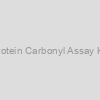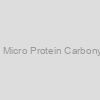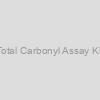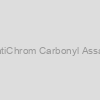Muscle meals, significantly fish merchandise are extremely uncovered to oxidative stress throughout processing and storage, leading to oxidative modification of proteins. Protein carbonyls content material has been used as one of many measures of oxidative stress.
Usually, the ensuing carbonylated proteins (CPs) have up to now been labeled with 2,4-dinitrophenyl (DNP) hydrazine and detected with anti-DNP antibody. Nonetheless, the applicability of this technique to meals samples is proscribed by its excessive worth, time-consuming process and risk to carry out the measurements simply on soluble protein fractions.
We developed a less complicated, sooner and cheaper technique to evaluate CP degree in muscle meals, together with each soluble and insoluble protein fractions, which relies on a direct response of protein carbonyls with 7-(diethylamino)coumarin-3-carbohydrazide (CHH).
The paper describes a novel method to label each soluble and insoluble carbonylated proteins with CHH and decide carbonyl content material by fluorescence microscopy assay which correlates (R = 0.911) with typical ELISA technique.
Protein and cell wall polysaccharide carbonyl willpower by a impartial pH 2,4-dinitrophenylhydrazine-based photometric assay.
A brand new 2,4-dinitrophenylhydrazine (DNPH)-based photometric assay is developed for the quantification of carbonyls in protein samples from any organic supply by protein carbonyl-DNPH hydrazone formation at acidic pH within the presence of denaturing urea, and subsequent hydrazone solubilization within the presence of SDS and stabilization from acid hydrolysis at pH 7.0. At this impartial (ntr) pH, interfering unreacted DNPH is uncharged and its thus elevated hydrophobicity permits its 100% efficient elimination from the solubilizate with ethyl acetate/hexane wash.
The ntrDNPH assay is extra dependable and delicate than the usual (std) DNPH photometric assay as a result of it eliminates its major limitations: (i) interfering unreacted DNPH (pKa 1.55) that’s nonspecifically sure to the TCA (pKa 0.7)-protein pellet isn’t successfully eliminated after wash with EtOH: ethyl acetate as a result of it’s positively charged, (ii) acid (TCA-induced) hydrolysis of the protein carbonyl-DNPH hydrazone, (iii) pattern protein focus re-determination, (iv) lack of pattern acid (TCA)-soluble proteins, (v) DNA interference, and (vi) requires excessive protein amount samples (≥ 1 mg). Contemplating ntrDNPH assay’s very low protein restrict (1 µg), its cumulative and purposeful sensitivities are 2600- and 2000-fold larger than these of the stdDNPH assay, respectively.
The current examine elucidates the DNA interference mechanism on the stdDNPH assay, and in addition develops a standardized protocol for pattern protein therapy and fractionation (into cytoplasmic/aqueous, membrane/lipid-bound, and histone/DNA-bound proteins; see Complement part V) as a way to guarantee reproducible carbonyl willpower on outlined cell protein fractions, and to get rid of assay interference from protein samples containing (i) Cys sulfenic acid teams (through their neutralization with dithiothreitol), and (ii) DNA (through its elimination by streptomycin sulfate precipitation).
Lastly, the ntrDNPH assay determines carbonyl teams on cell wall polysaccharides, thus paving the best way on research to analyze cell partitions appearing as antioxidant protection in vegetation, fungi, micro organism and lichens.
Protein carbonyl willpower by a rhodamine B hydrazide-based fluorometric assay.
A brand new fluorometric assay is introduced for the ultrasensitive quantification of whole protein carbonyls, and relies on their particular response with rhodamine B hydrazide (RBH), and the manufacturing of a protein carbonyl-RBH hydrazone the fluorescence of which (at ex/em 560/585 nm) is significantly enhanced by guanidine-HCl.
In comparison with the fluorescein-5-thiosemicarbazide (FTC)-based fluorometric assay, the RBH assay makes use of a 24-fold shorter response incubation time (1 h) and at the very least 1000-fold decrease protein amount (2.5 µg), and produces very dependable knowledge that have been verified by intensive standardization experiments.
The protein carbonyl group detection sensitivity restrict of the RBH assay, primarily based on its commonplace curve, will be as little as 0.Four pmol, and even decrease. Counting the very low protein restrict of the RBH assay, its cumulative and purposeful sensitivity is 8500- and 800-fold larger than the corresponding ones for the FTC assay. Neither heme proteins hemoglobin and cytochrome c nor DNA intrude with the RBH assay.
A fluorimetric semi-microplate format assay of protein carbonyls in blood plasma.
Oxidative stress, originating from reactive oxygen species (ROS), has been implicated in getting old and numerous human ailments. The ROS generated can oxidize proteins producing protein carbonyl derivatives. The extent of protein carbonyls in blood plasma has been used as a measure of general oxidative stress within the physique. Classically, protein carbonyls have been quantitated spectrophotometrically by straight reacting them with 2,4-dinitrophenylhydrazine (DNPH).
Nonetheless, the applicability of this technique to organic samples is proscribed by its low inherent sensitivity. This limitation has been overcome by the event of delicate enzyme-linked immunosorbent assay (ELISA) strategies to measure protein carbonyls. As a part of the Wholesome Getting older in Neighborhoods of Range throughout the Lifespan (HANDL) examine, oxidative stress in people was quantified by measuring blood plasma protein carbonyls utilizing the 2 commercially obtainable ELISA kits and the spectrophotometric DNPH assay.
Surprisingly, two ELISA strategies gave very completely different values for protein carbonyls, each of which have been completely different from the worth of the spectrophotometric technique. We’ve developed a fluorescent semi-microplate format assay of protein carbonyls involving direct response of protein carbonyls with fluorescein thiosemicarbazide that correlates (R=0.992) with the direct spectrophotometric technique. It has a coefficient of variation of 4.99% and is at the very least 100 occasions extra delicate than the spectrophotometric technique.
Antioxidants alleviate electrical field-induced results on lung tissue primarily based on assays of heme oxygenase-1, protein carbonyl content material, malondialdehyde, nitric oxide, and hydroxyproline.
With a view to take a look at whether or not antioxidants have beneficiary results on electrical area induced injury, we decided the pulmonary ranges of heme oxygenase-1 (HO-1), protein carbonyl content material (PCO), malondialdehyde (MDA), nitric oxide (NO) and hydroxyproline (HP) below extraordinarily low frequency (ELF) electrical (E) area publicity (50 Hz, 12 kV/m, 7 days/for eight h/day).
Whereas PCO ranges considerably elevated (p<0.05), insignificant adjustments (p>0.05) have been noticed in HO-1, MDA, NO and HP ranges for electrical area publicity teams in comparison with the management group. We’ve not noticed any vital change in these parameters on the electrical area group in comparison with the group the place NAC and EGCG have been individually utilized together with electrical area.
 Protein Carbonyl Assay Kit |
|||
| abx294083-100g | Abbexa | 100 µg | Ask for price |
 Protein Carbonyl Assay Kit |
|||
| abx294083-20g | Abbexa | 20 µg | EUR 337.5 |
 Protein Carbonyl Assay Kit |
|||
| abx294083-50g | Abbexa | 50 µg | Ask for price |
 Protein Carbonyl Assay, Catalog: MA-0150 |
|||
| MA-0150 | Akrivis Bio | 100 wells | EUR 320 |
|
Description: A plate based colorimetric assay to measure protein carbonyls in a variety of samples with a sensitivity well below 1 nmole. |
|||
 Protein Carbonyl Content Assay Kit |
|||
| 55R-1546 | Fitzgerald | 100 assays | EUR 460 |
|
Description: Assay Kit for detection of Protein Carbonyl Content in the research laboratory |
|||
 Protein Carbonyl Content Assay Kit |
|||
| GWB-AXR379 | GenWay Biotech | 100 assays | Ask for price |
 Protein Carbonyl Content Assay Kit |
|||
| K2188-100 | ApexBio | 100 assays | EUR 381 |
|
Description: Simple assay to quantify protein carbonyls |
|||
 Protein Carbonyl Content Assay Kit |
|||
| K830-100 | Biovision | each | EUR 516 |
 CheKine™ Micro Protein Carbonyl Assay Kit |
|||
| KTB1200-48T | Abbkine | 48 T | EUR 69 |
|
Description: Abbkine CheKine™ Micro Protein Carbonyl Assay Kit is designed for detecting Protein Carbonyl content in the sample. |
|||
 CheKine™ Micro Protein Carbonyl Assay Kit |
|||
| KTB1200-96T | Abbkine | 96 T | EUR 119 |
|
Description: Abbkine CheKine™ Micro Protein Carbonyl Assay Kit is designed for detecting Protein Carbonyl content in the sample. |
|||
 CheKine™ Micro Protein Carbonyl Assay Kit |
|||
| KTB1200-each | Abbkine | each | Ask for price |
) Protein Carbonyl Content Assay Kit (Fluorometric) |
|||
| K563-100 | Biovision | each | EUR 529.2 |
 OxiSelect™ Protein Carbonyl Fluorometric Assay |
|||
| STA-307 | Cell Biolabs | 100 assays | EUR 580 |
 Total Carbonyl Assay Kit |
|||
| abx294110-100g | Abbexa | 100 µg | Ask for price |
 Total Carbonyl Assay Kit |
|||
| abx294110-20g | Abbexa | 20 µg | EUR 325 |
 Total Carbonyl Assay Kit |
|||
| abx294110-50g | Abbexa | 50 µg | Ask for price |
 QuantiChrom Carbonyl Assay Kit |
|||
| DCAR-100 | BioAssay Systems | 100 | EUR 369 |
 OxiSelect Protein Carbonyl Fluorometric Assay, Trial Size |
|||
| STA-307-T | Cell Biolabs | 20 assays | EUR 421.2 |
|
Description: The most common products of protein oxidation in biological samples are the carbonyl derivatives of proline, lysine, arginine and threonine residues. Such derivatives are chemically stable and serve as markers for oxidative stress in most types of reactive oxygen species. Our OxiSelect Protein Carbonyl Fluorometric Assay Kit provides a rapid, efficient method for the detection of protein carbonyl residues. The fluorescence plate-based format provides a convenient system for direct measurement of protein carbonyl content. |
|||
Nonetheless, throughout our earlier research, now we have concluded that NAC and EGCG are potent antioxidants and we imagine that new research must be established by means of organising completely different experimental circumstances.

